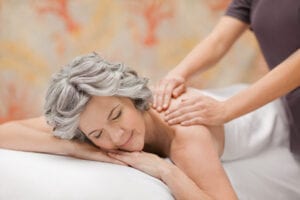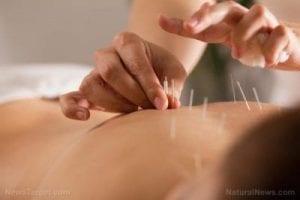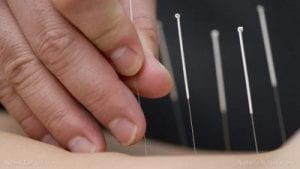One of the oldest, most commonly used systems of healing in the world. Originating in China some 3,500 years ago, only in the last three decades has it become popular in the United States. In 1993, the Food and Drug Administration estimated that Americans made up to 12 million visits per year to acupuncture practitioners and spent upwards of half a billion dollars on acupuncture treatments. Traditional Chinese medicine hold that there are as many as 2,000 acupuncture points on the human body, which are connected by 20 pathways (12 main, 8 secondary) called meridians. These meridians conduct energy, or qi (pronounced “chi”), between the surface of the body and its internal organs. Each point has a different effect on the qi that passes through it.
According to the most recent National Health Statistics Report, compiled by the U.S. Centers for Disease Control and Prevention (CDC), an estimated 3.5 million American adults receive acupuncture treatments each year.1 Used for thousands of years, this therapeutic technique involves inserting ultrafine needles into the surface of your skin at specific points along your body’s defined energy pathways, which are also known as meridians.
Acupuncture needles are either stimulated by hand or electrically as a means of safely and effectively relieving common health complaints such as back and neck pain, fibromyalgia, headaches, osteoarthritis, shoulder pain and more.
The main aspect of acupuncture that sets it apart from conventional, symptom-based medicine is the fact it seeks to eliminate the root cause of your problem by uncovering dysfunction in your body’s energetic meridian system. Keep reading for all you need to know about acupuncture and how it works.
What Is Acupuncture?
The main goal of acupuncture is to rebalance your body so its energy flow, also called the qi (pronounced “chee”), is able to circulate freely and harmoniously. In layperson terms, acupuncture stimulates the flow of oxygen, nutrients and blood throughout your body in a way that supports your body’s natural ability to heal itself. Encyclopedia Britannica offers the following additional information about acupuncture:2
- The practice of acupuncture centers around the inserting of ultrafine, metal needles into your skin at specific points on your body along energy pathways, or meridians, that run from the top of your head to the bottom of your feet
- This ancient medical technique, which many believe originated with the Chinese, has been used in Asian cultures for thousands of years to cure disease, relieve pain and improve general health
- Acupuncture is believed to have developed out of the ancient Chinese theory of the yin — characterized as female, passive, dark and represented by earth — and the yang — male, active, light and represented by the heavens
- Chinese tradition suggests disease or physical disharmony is caused by a yin-yang imbalance and only by balancing the yin and the yang can you experience good health
- Yin-yang imbalances block your body’s qi, which is significant because your qi flows through 12 basic meridians that are associated with your major visceral organs and each functional body system
Acupuncture Interacts With Your Body’s Energy System
At a basic level, your body is an energy system. Your cells are always communicating with each other via chemical signals. These chemical signals require a spark of energy to move throughout your body. When properly energized, your cells support your every movement, thought and bodily function.
Even though you cannot see it, an invisible web of energy connects each part of your body in an orderly way to promote proper function and growth and, when necessary, healing and restoration. In Traditional Chinese Medicine (TCM) your body’s energy moves along meridians and they are the foundation of how acupuncture works. About your body’s meridians, TCM practitioner Angela Warburton, writing for The Hearty Soul, says:3
“The fluid in these fascial planes, are rich in ions and an excellent conductor of electricity. When we are healthy, they are free of any obstructions which makes flow in these channels easy. When we are ill or in pain, this space or these channels get compromised or blocked. Where there is a blockage, cells do not flow or communicate as well and the body starts to show signs or symptoms.
When they are blocked, things can’t get through. This is where dis-ease sets in. The body usually sends a sign when something is off or blocked. Pain or discomfort is the body’s way of letting us know something needs attention. Energy disturbance is the root of all diseases. When something is wrong with this flow of energy, our nervous system brings us a message [in the form of] pain, discomfort or dis-ease.”
Warburton notes your body signals problems in the energy flow well before any long-term damage has occurred. “Pain is simply the messenger, not the problem,” she says. “If we simply medicate to make the pain go away, we’re missing the problem — and just shooting the messenger!”4
Rather than ignore the signs and symptoms your body uses to alert you to underlying issues, Warburton validates the usefulness of acupuncture to look at “every little ache, pain, sign and symptom” as a means of not only listening to your body, but also as a means of improving energy flow and clearing up any energy blockages.5
Hypotheses Regarding How Acupuncture Works
While Eastern medicine practitioners believe acupuncture is all about the qi, Western scientists continue to study the mechanism of acupuncture in an attempt to figure out how it works. So far, Western researchers have proposed a few hypotheses about how acupuncture works, including:6
- Acupuncture works through your neurohormonal pathways: About this theory, Dr. Ting Bao, an integrative medical oncologist at Memorial Sloan-Kettering Cancer Center in New York, notes the placement of acupuncture needles stimulates nerves and triggers your body’s own natural painkillers.
- She says, “The nerve sends signals to the brain and the brain releases neural hormones such as beta-endorphins. By doing that, the patient may feel euphoric, or happy, and this increases the pain threshold and they feel less pain.”
- Acupuncture works by reducing pro-inflammatory markers: Some animal and human studies, notes Bao, suggest acupuncture helps significantly decrease your body’s pro-inflammatory markers. In one animal study, manual acupuncture was able to turn off pro-inflammatory M1 macrophages while activating anti-inflammatory M2 macrophages. These actions increased interleukin-10 (IL-10) concentrations in muscle, thereby reducing pain and swelling.7
- Acupuncture works by stimulating your hypothalamus and pituitary gland: Others, like Kylie Study, licensed acupuncturist and traditional Chinese medicine practitioner with Michigan’s Beaumont Health System, don’t believe acupuncture directly triggers the release of the “feel-good” chemicals that help your body deal with inflammation, stress and other problematic conditions.
Instead, says Study, acupuncture “works higher up the chain, such as affecting your pituitary gland to produce the extra hormones.”8
The reality is acupuncture likely works via a variety of mechanisms. Because it has been proven to impact a number of chronic health conditions, acupuncture may work, in part, by stimulating your central nervous system to release natural chemicals that alter your bodily systems, pain and other biological processes.
A 2010 study, for instance, published in the journal Nature Neuroscience,9 highlighted acupuncture’s ability to activate pain-suppressing receptors and increase the concentration of the neurotransmitter adenosine in local tissues. Adenosine slows down your brain’s activity and induces sleepiness.
Conditions for Which Acupuncture Has Been Shown Effective
In the late 1970s, the World Health Organization recognized the ability of acupuncture and Oriental medicine to treat nearly four dozen common ailments, including neuromusculoskeletal conditions (such as arthritis, neuralgia, insomnia, dizziness, and neck/shoulder pain); emotional and psychological disorders (such as depression and anxiety); circulatory disorders (such as hypertension, angina pectoris, arteriosclerosis and anemia); addictions to alcohol, nicotine and other drugs; respiratory disorders (such as emphysema, sinusitis, allergies and bronchitis); and gastrointestinal conditions (such as food allergies, ulcers, chronic diarrhea, constipation, indigestion, intestinal weakness, anorexia and gastritis).
In 1997, a consensus statement released by the National Institutes of Health found that acupuncture could be useful by itself or in combination with other therapies to treat addiction, headaches, menstrual cramps, tennis elbow, fibromyalgia, myofascial pain, osteoarthritis, lower back pain, carpal tunnel syndrome and asthma.
Other studies have demonstrated that acupuncture may help in the rehabilitation of stroke patients and can relieve nausea in patients recovering from surgery.
In 2003, the World Health Organization (WHO) published a report based on its review of 255 clinical studies involving acupuncture as a treatment modality. Based on that analysis, the WHO asserts acupuncture has been proven through controlled clinical trials to be an effective treatment for the following conditions:10
- Adverse reactions to chemotherapy and/or radiotherapy
- Allergic rhinitis, including hay fever
- Blood pressure issues
- Chronic pain, including back pain, headache (including migraines), neck pain, osteoarthritis11 and shoulder pain12
- Dental pain, including temporomandibular dysfunction
- Depression, including depressive neurosis and depression following stroke
- Epigastralgia as in acute and chronic gastritis, gastrospasm and peptic ulcers
- Facial pain, including craniomandibular disorders
- Fibromyalgia14
- Leukopenia
- Menstrual-related aches and pain
- Morning sickness
- Nausea and vomiting, including postoperatively13
- Rheumatoid arthritis
- Sciatica
- Sprains
- Stroke
- Tennis elbow
As you may have noticed, acupuncture is rarely used to treat specific diseases such as cancer or diabetes. That is because most practitioners focus on using acupuncture as a complementary medicine treatment and few, if any, studies have pursued its usefulness for preventing or directly treating major diseases.
About its usefulness for breast cancer patients, Bao said acupuncture is used to “alleviate cancer treatment-induced side effects or cancer-induced symptoms, but never to directly treat cancer. It would be really interesting to see if acupuncture could help prevent cancer, but I don’t think the research has reached that level yet.”15
Trying Acupuncture for the First Time? Here’s What to Expect
When practiced by a licensed, trained acupuncturist, acupuncture is extremely safe. As a system of health care, acupuncture already has some inherent safeguards. Because the treatment is drug-free, patients do not have to worry about taking several doses of a medication or suffering a possible adverse reaction.
Properly administered, acupuncture does no harm. However, there are certain conditions you should notify an acupuncturist about before undergoing treatment. If you have a pacemaker, for instance, you should not receive electroacupuncture due to the possibility of electromagnetic interference with the pacemaker. Similarly, if you have a tendency to bleed or bruise easily, or if you are a hemophiliac, you may want to consider a different type of care. (AcupunctureToday)
If you are trying acupuncture for the first time, below are some tips to make your first appointment more comfortable and successful:16
- What to wear: Because acupuncture points are located throughout your body and may be far removed from the area where you are experiencing pain or other symptoms, it’s best to wear loose-fitting clothing. Depending on your situation, you may need to slip into a gown or be draped with a sheet or towel. Very often, you will receive the treatment while lying down on a massage table or other padded surface.
- Inserting the needles: Acupuncture needles are extremely thin, sterile and single-use. The ultrafine tips are easily inserted into the surface of your skin, resulting in minimal discomfort. Instances of bleeding and bruising are rare. You may experience a mild aching or tingling sensation. A typical treatment involves the insertion of between five and 20 needles.
- Manipulating the needles: Once the needles are in position, your practitioner may manipulate them either by hand, using heat or with a device that generates mild electrical pulses. These methods are used to stimulate your body’s meridians to help restore energy flow.
- Relaxing with the needles: In most cases, the needles will remain in place for 10 to 30 minutes to promote a period of relaxation while the treatment achieves its desired effects. Most people find the relaxation period to be calming and beneficial because it usually takes place in a darkened room. You may even fall asleep.
- Removing the needles: When the treatment is complete, your practitioner will return to remove the needles, which he or she will safely discard as medical waste. Each insertion point may be dabbed with rubbing alcohol, marking the completion of the treatment.
In terms of how you will feel after an acupuncture session, some report feeling very relaxed, whereas others feel completely energized. It will take more than one session for your body to experience relief from any troubling symptoms. While an acupuncture practitioner is the best one to estimate the length of your treatment, you should plan on having multiple sessions over a period of weeks or months to fully address most conditions.
If your symptoms do not begin to improve after a series of sessions, acupuncture may not be an effective treatment for your issue. Or, at the least, it may not be a suitable treatment for you at this particular time. You can discuss other possible treatment options with your practitioner.
Want the Benefits of Acupuncture Without the Needles? Try EFT
If you are interested in receiving some of the benefits of acupuncture without the prick of needles, you might want to try the Emotional Freedom Techniques (EFT). EFT is a painless psychological acupressure technique I highly recommend to help optimize your emotional health. While often overlooked, your emotional health is connected to and has a great deal of influence over your physical health and well-being.
Irrespective of how devoted you are to eating well and living a healthy lifestyle, your success will be somewhat limited until you deal with your emotional baggage, much of which, believe it or not, very likely has been following you since childhood. EFT works because it is based on the same energy meridians used in acupuncture to treat physical and emotional ailments. Rather than inserting needles into specific points along your body’s energy meridians, however, you will simply tap over some of those areas using your fingertips.
As you tap, you’ll be thinking about and talking through your specific problem, whether it be an addiction, anxiety, physical pain or a traumatic event. Along the way, you’ll voice positive affirmations. In the video above, EFT practitioner Julie Schiffman demonstrates how to tap to gain relief from physical pain. This is just one of the many areas that have been shown to respond well to EFT.
As you’ll discover, the combination of tapping the energy meridians and voicing positive affirmation works to clear any emotional blocks, thereby restoring and balancing the connection between your mind and body. Because the results are quick and painless, EFT is sure to become one of your “go-to” healing tools. To learn more about EFT and how it works, as well as the many conditions and situations to which it can be applied, check out my EFT home page.
Source: Mercola.com
Additional Resources:
Related History:

Non-pharmacologic Treatments may be more Effective for Psychiatric Symptoms of Dementia

Study: Acupuncture is safe and effective Method in Improving the Cognitive Function, Global Clinical Status of Alzheimer’s Disease

Scientific Study Sheds Light on Why Acupuncture is so Effective for Pain Control





